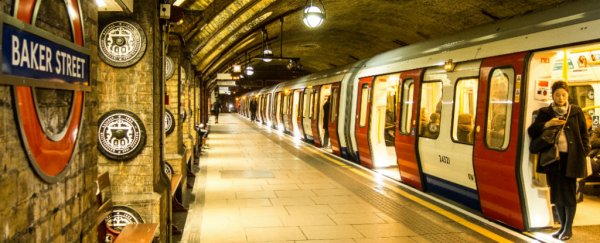London has just finished testing a new system that can collect and recycle energy generated by their Tube trains when they brake, and it's already powering their stations completely for more than two days per week.
The world-first, five-week trial was conducted on the Victoria line of the London Underground (LU), which reportedly transports 1.2 billion passengers across a total of 76.2 million km every year, with some stations catering to 89 million people. The city reports that it's already shaving 5 percent off the annual energy bill, which might not sound like much, but that equates to about £6 million (US$9 million) every year that can be spent on improving the line.
"The trial puts London at the cutting edge of this kind of technology and clearly demonstrates how energy from trains can be recovered to power Tube stations, making the network more environmentally friendly and cost-effective," Matthew Pencharz, Deputy Mayor for Environment and Energy, said in a press statement. "This complements our wider work to make other forms of public transport cleaner and greener, including our buses, where we have introduced hybrid and zero-emission technology."
The technology used is called an inverter system, which has been installed at the Cloudesley Road substation on the Victoria line. The system works by collecting energy generated by the trains when they brake before feeding it back into the power mains as electricity. "In hybrid and electric cars, such recovery systems can help improve range, but in large heavily-packed passenger trains running regularly in one of the most heavily traveled cities in the world, the effects can be significant," David Szondy writes for Gizmag.
According to the London transport authority, it collected an average of 1 Megawatt hour (MWh) of energy each day, which is enough to cover the line's biggest stations, such as Holborn, for more than two days. The city will now be running the system permanently.
Another benefit of the inverter system is that by collecting up the energy and turning it into electricity, it prevents the train from converting it into heat. Normally, all that heat energy is radiated throughout the London Underground, and it requires a whole lot of air-conditioning to combat - presumably one of the biggest power saps the stations are dealing with.
"This state-of-the-art regenerative braking system has the potential to transform how we power stations across the … network, unlocking massive power savings and significantly reducing our energy bills," Chris Tong, LU's Head of Power and Cooling, said in a press release. "We are committed to doing more to reduce our energy use, and this technology - a world-first for metro railways - is one of a number of innovations we're embracing to lower our environmental impact."
According to the local government, this system is just one of a bunch of new initiatives they're undertaking to make the public train system more environmentally friendly. Earlier this year, they announced that the Greenwich Power Station in southeast London would be converted into a low-carbon power generator for the Tube network, and they'll be installing six new gas engines to replace existing boilers, which will provide cheaper, cleaner power for their trains.
We have a feeling other major cities around the world will be following suit in the coming decades, not just because it's better for the environment - you just can't argue with the economics of renewables anymore, so why fight it?
